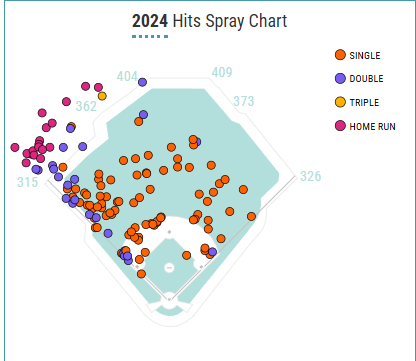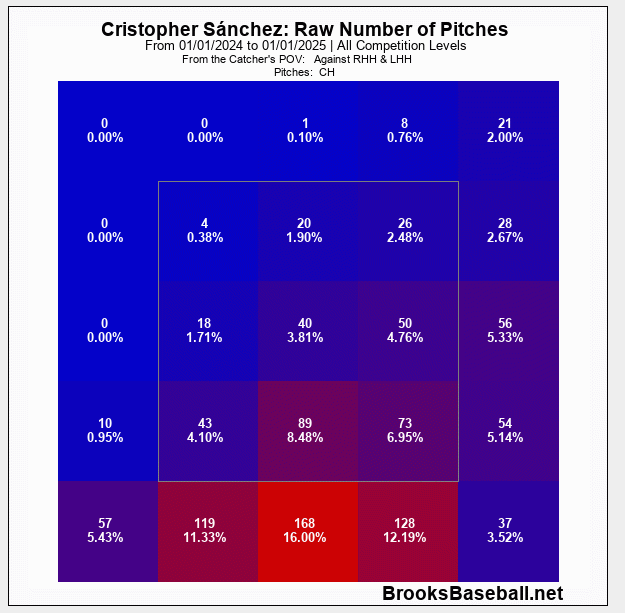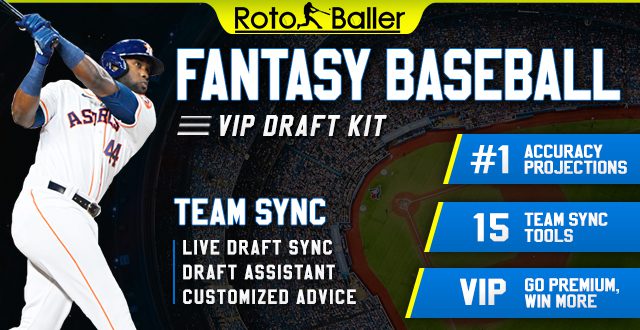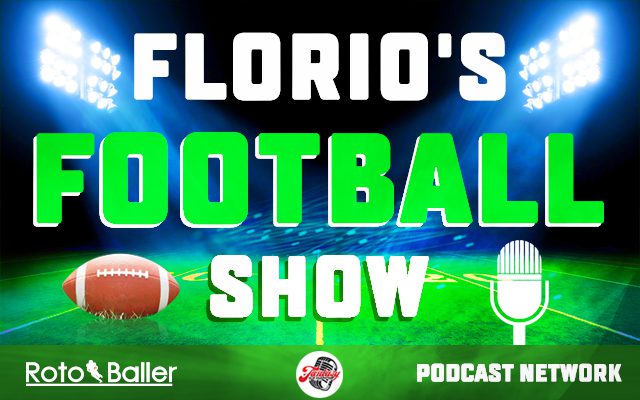Has there been a better revelation for the baseball obsessive than Statcast? It can tell you everything you ever wanted to know about a player and more, and it makes fantasy baseball all the more fun, and challenging. With so much information, it can be difficult to know where to start or what to look for.
If you've ever felt this way, or just don't feel like poking around Baseball Savant, no worries! I've identified six Statcast standouts--three hitters and three pitchers--who excelled in various metrics from last season. These Statcast metrics suggest that there's some serious potential lurking in these players, and they may overperform their draft day cost.
These players are being selected after pick No. 150 in drafts, making them mid- and late-round values. ADP is taken from NFBC and is accurate as of 3/19/25. For a deeper dive into ADP trends and strategies, check out our Fantasy Baseball ADP Guide to gain an edge on draft day.
Be sure to check all of our fantasy baseball lineup tools and resources:- Fantasy baseball trade analyzer
- BvP matchups data (Batter vs. Pitcher)
- PvB matchups data (Pitcher vs. Batter)
- Who should I start? Fantasy baseball comparisons
- Daily MLB starting lineups
- Fantasy baseball closer depth charts
- Fantasy Baseball live scoreboard
- Fantasy baseball injury reports
Fantasy Baseball Statcast Standouts - Hitters
Michael Toglia, 1B/OF, Colorado Rockies
NFBC ADP: 179.46
Key 2024 Statcast Metric: 17.3 percent barrel rate
When it comes to advanced hitting metrics, I absolutely love hitters with a high barrel rate. A few seasons ago, I did an analysis for RotoBaller and found a strong correlation between a hitter's barrel rate and isolated power. The higher a hitter's barrel rate, the more likely he is to hit for power, and it correlated much more strongly than other Statcast metrics.
Toglia was a standout in this category in 2024, putting up a monster 17.3 percent barrel rate, tied for fifth-best in the majors among qualified hitters last season. The top of the barrel rate leaderboard is practically a who's who of power hitters, and Toglia ranks high among them.
He was a monster across the board in Statcast. Have a look at his batting percentiles, for crying out loud!
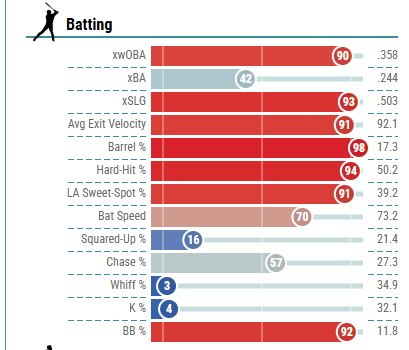
Toglia was better in just about every metric in 2024, and his spike in barrel rate stands out. He had a 5.5 percent barrel rate in 2023 but more than tripled that number to 17.3 percent in 2024. He also improved his exit velocity to a blistering 92.1 mph, his xSLG to .503, and his xwOBAcon to .496.
Toglia was a Statcast monster last season, and that's a big reason why he was able to go from a .163/.224.284 slash line in 2023 to a .218/.311/.456 line in 2024 with 25 home runs and 10 steals. He struggled in the first few months, but Toglia turned things on in July, hitting .232 with an .805 OPS and .232 ISO and 13 home runs in 320 PA.
His plate discipline improved big time, going from a 5.8 percent walk rate through June 30 to a 14.4 percent walk rate from July 1 onward. He even reduced his strikeout rate, though it was still too high at 31.3 percent.
You can also see Toglia's most significant weakness in that graph, as he ranks toward the bottom of the league in strikeout and contact rates. Toglia sort of reminds me of a pre-breakout Brent Rooker. Excellent Statcast numbers, but strikes out way too much.
He makes excellent quality of contact, has been making strides at the plate, and plays his home games in Coors Field. If (and this is a big if) he can reduce his strikeout rate, he could really take off as a player. I love drafting Toglia at value as a cheap first baseman or corner infielder this draft season.
Isaac Paredes, 3B, Houston Astros
NFBC ADP: 195.41
Key 2024 Statcast Metric: 34.5 percent pull air rate
One of the return pieces Houston got in the Kyle Tucker trade, Paredes is in line to benefit big time from his new home ballpark. He's long been an extreme pull hitter, and Daikin Park had a 109 HR and 109 2B factor for right-handed hitters last season.
The left field fences are famously short in Houston, just 315 feet down the line, thanks to the Crawford boxes.
Paredes smacked 31 home runs with a .238 ISO with Tampa Bay in 2023 before taking a big step back last season with 19 homers and a .155 ISO. Could this high air rate suggest a turnaround is near? And what even is air rate, anyway?
Air rate is a new Statcast metric that's exactly what it sounds like. Air rate measures any batted ball that is not a groundball. Line drives are by far the most likely batted ball type to land for a hit, and flyballs are much more likely to produce power, making them more valuable outcomes than a grounder.
For context, the league average OPS on a groundball in 2024 was .514, while the OPS on flyballs was .854 and on line drives was 1.595. Remember a few years ago when we had a "launch angle revolution" in MLB? This is why.
Isolating the air rate even further, Statcast tells us that "pulled airballs" are the most valuable type of hit in terms of power.
According to the Statcast website, 66 percent of all home runs between 2022-2024 were "pulled airballs," and batters hit .547 with a .733 wOBA on pulled airballs between 2022-2024, compared to a .319 AVG and .353 wOBA on non-pulled airballs.
Now, back to Paredes. He led the league with a 34.5 percent pulled air rate in 2024 and was third in the league in 2023 with a 35.2 percent pulled air rate, yet his home runs went down from 31 in 2023 to 19 in 2024.
One reason for this is an unfortunate 9.4 percent HR/FB ratio. Paredes had a 16.5 percent HR/FB ratio in 2022 and a 16.9 percent HR/FB ratio in 2023, so it would be reasonable to expect a bounce back in that metric in 2025, especially with his new home ballpark.
Wrigley Field did not play well for right-handed power in 2024, with a 67 2B factor and a 90 HR factor for righties in 2024. Tropicana Field was technically better but had an 83 2B factor and a 99 HR factor for righties.
Anyway you slice it, Daikin Park is a big upgrade. Here, have a look at his 2024 spray chart overlayed with Daikin Park.
Look at that batted ball distribution. And look at how many doubles become home runs. It's like they built the park solely so Paredes could hit dingers.
One area of concern with Paredes is how weakly he hits the ball. Sure, he's a pull monster, but he only had an 85 mph average exit velocity and a 4.5 percent barrel rate last season. Those aren't the numbers we typically see from a power hitter. I also hesitate to suggest that he could get back to being a 30-HR bat.
He had 31 homers in 2023. But had 23.8 xHR per Statcast. His "no doubter" percentage that year was just 19.4 percent, compared to a league average "no doubter" percentage of 38.7 percent in 2024 (min. 10 home runs).
It would take a lot of things breaking right for Paredes to be a 30-homer guy again; he's probably closer to a 20-25 home run bat, even in Daikin Park. Still, he is cheap on draft day and a good bounce-back candidate, seemingly a perfect fit for Houston.
Ben Rice, C/1B, New York Yankees
NFBC ADP: 473.53
Key 2024 Statcast Metric: .459 xSLG (vs. .349 actual SLG)
There's no sugarcoating it: Ben Rice was awful last year. He slashed .171/.264/.349 with a 27 percent strikeout rate in 178 PA. Bad as that season was, there are some indications that more power lurks in Rice's bat.
With Giancarlo Stanton (elbow) on the shelf for the foreseeable future, Rice has the chance to step in and be the Yankees DH, at least against right-handed pitchers. A power-hitting lefty in Yankee Stadium is always interesting, so can we find any value in Rice?
Yes, Rice was awful in the majors last season, but there are things to like on his Statcast page. First, he had a monster 15.6 percent barrel rate last season and a 90 mph average exit velocity. Throw in a 17.7-degree average launch angle, and it's easy to see why his xSLG was so much higher than his actual slugging percentage.
In fact, Rice had the largest discrepancy between his xSLG and actual SLG last season, with a 110-point difference. He also had the largest discrepancy between his wOBA (.269) and xwOBA (.340). Usually, players who struggle will have the biggest discrepancies because they have so much space between them and the league average, but in Rice's case, the numbers suggest power.
Rice displayed some power at the minor league level as well. Last year in the minors, he had 24 home runs and a .294 ISO in 356 PA. He hit 12 of those homers and an insane .367 ISO in 138 PA at Triple-A.
Rice also only had a 20.2 percent strikeout rate and a 16 percent walk rate, so perhaps he could display some better plate discipline this season or at least put up a good OBP.
He's probably not worth drafting in standard 10- or 12-team leagues, but anything deeper and Rice gets interesting as a late-round flier. Bonus points if Rice is eligible as a catcher in your league, as he played some catcher in the minors.
Fantasy Baseball Statcast Standouts - Pitchers
Cristopher Sanchez, SP, Philadelphia Phillies
NFBC ADP: 180.88
Key 2024 Statcast Metric: 22 percent hard-hit rate vs. changeup
Sanchez is coming off a breakout season where up posted a 3.32 ERA, 3.00 FIP, and 3.48 K/BB in 181 2/3 innings in 2024. Sanchez wasn't a big strikeout pitcher last season with just 7.58 K/9, but his velocity has spiked up this spring and he has 10.26 K/9 in five spring starts as of writing this.
What I really like about Sanchez is that he is on the extreme end of the spectrum in several areas, including with his elite changeup.
Batters really struggled against Sanchez's changeup last season, hitting just .177 with a .220 SLG and .190 wOBA. The expected stats indicate that Sanchez also earned these results, with a .178 xBA, .225 xSLG, and .190 xwOBA.
Opponents had a paltry 83 mph average exit velocity against the pitch, along with the 22 percent hard-hit rate mentioned above. It was the fifth-lowest hard-hit rate allowed on a singular pitch in the majors last season, up there with other elite offerings like Chris Sale's slider and Cole Ragans' changeup.
Batters also have a 1-degree average launch angle against the pitch, so all they do with it is hit soft grounders.
It would be one thing if the positive attributes of Sanchez's changeup ended there, but it also has the makings of a dominant strikeout offering. Sanchez had a 34.8 percent whiff rate with the pitch last season, seventh-best among changeups in the majors. He also has a 44.4 percent chase rate with the pitch and ranks in the 98th percentile in chase rate in MLB.
Have a look at his changeup heatmap from last year.
Notice a pattern? Low, low, low.
He has just a 37 percent zone rate with the pitch, which means batters are often swinging at the junk that causes them to miss or ground out. Sanchez boasts one of the best changeups in baseball, and with this pitch, he could grow his strikeout rate and maintain his strong ground-ball rate.
The changeup isn't the only good pitch for Sanchez, either. His fastball velocity has spiked up to 98 mph this spring, and he has a 29.2 percent strikeout rate in five outings. He might not have a strikeout rate that high in the regular season, but gains could be coming. Sanchez's sinker is already a great groundball pitch, with a 53.3 percent ground-ball rate last season.
Maybe he can blow it past hitters this year or induce more favorable contact for himself. Despite the ground-ball rate, batters did hit .345 off his sinker last season. I'd expect the .370 BABIP off his sinker to normalize toward the league average this year, giving him better outcomes.
Sanchez ranks near the top of the league in ground-ball rate, chase rate, and hard-hit rate allowed. He's also working on adding a cutter to his pitch mix this season. He seems to have all the ingredients to take his game to the next level.
I think Sanchez is great mid-round value, a stable arm with breakout potential on a winning club.
Clay Holmes, SP, New York Mets
NFBC ADP: 281.89
Key 2024 Statcast Metric: 35.4 percent air rate against
Holmes is coming off a dominant three-year stretch as the closer in the Bronx, putting up 74 saves and a 2.85 ERA, along with a 17.5 percent K-BB% between 2022 and 2024 with the Yankees. The Mets liked his performance so much that they signed Holmes to a three-year deal this offseason to work as a starter.
It's become a new trend in baseball for teams to try converting dominant relievers to starters, with the most notable recent success being Reynaldo Lopez for the Braves last season.
Is Holmes this year's Lopez? There's a lot to like in Holmes' profile, but let's start by focusing on the newest Statcast metric, air rate. As discussed under the Isaac Paredes header, air rate is simply the percentage of hits that are not groundballs, so line drives, flyballs, and popups.
We know that line drives are most likely to become hits, and flyballs are most likely to become home runs, so a pitcher with a low air rate would likely excel at suppressing power and inducing groundballs.
Holmes had the third-lowest air rate in the majors last season. Holmes has certainly been able to suppress power as a reliever. Holmes has just a 0.4 HR/9 and a 68.6 percent ground-ball rate between 2022 and 2024, both elite numbers.
Holmes gets it done thanks to his power sinker, a 96.6 mph offering that had a -4-degree average launch angle against last season.
With the transition to starter, there is some question as to whether Holmes can maintain that velocity, but he's been averaging 95-96 mph with his sinker this spring. He has been an elite groundball pitcher as a reliever, and while it might be tough to maintain a 68.6 percent ground-ball rate, I could see him near the top of the league in this metric among starters this season.
Suppressing power isn't all Holmes does right. He's also been a great strikeout pitcher as a reliever, thanks to his dominant slider-sweeper combo. Batters struggled mightily against both pitches last season. Against the slider, they hit .133 with a .224 wOBA and a 40.7 percent whiff rate.
Against the sweeper, they hit .172 with a .199 wOBA and a 38 percent strikeout rate. Holmes boasts above-average vertical movement on both pitches, and while I wouldn't expect these whiff numbers to hold as a starter, he could still be a plus strikeout pitcher. He certainly has the stuff to do so.
Holmes has also worked on adding a changeup this spring, rounding out his arsenal with four (hopefully) solid pitches. Holmes is an interesting pitcher to watch this season because if he can carry over his bullpen success to the rotation, he'll be incredibly valuable.
He's a great dart throw late in drafts. Groundball pitchers who can get strikeouts can put up some nutty numbers when things break their way, so why not take a chance on Holmes?
Reid Detmers, SP, Los Angeles Angels
NFBC ADP: 389.71
Key 2024 Statcast Metric: .314 xwOBA against (vs. .370 actual wOBA)
UPDATE 3/24: Reid Detmers will start the season in the bullpen, and is set for a long-relief/swing role to open the year.
Detmers got crushed last season to the tune of a 4-9 record, 6.70 ERA, and 4.72 FIP. He didn't pitch his best and suffered some misfortune on top of it. Still, one doesn't have to look too deeply into this profile to see the potential. Despite the struggles, Detmers had a 27.9 percent strikeout rate and a 3.77 SIERA, three runs lower than his actual ERA.
A former top prospect and first-round pick, the hype is off Detmers coming into this season as he's currently going at pick No. 389 in NFBC drafts. He's basically free in standard leagues as well. Is there any value to be had here?
I mentioned that Detmers had some misfortune last season, and that's where his .314 xwOBA comes into play. Detmers allowed an ugly .370 wOBA against, but he had the largest differential between his actual wOBA of .370 and his xwOBA of .314. .314 isn't amazing, but it's more middle of the pack compared to his ugly results.
Detmers suffered from an unlucky .357 BABIP against, an uncharacteristically high 17.1 percent HR/FB rate, and a 62.9 percent left-on-base-percentage (LOB) rate. His BABIP rose despite a career-low 17.9 percent line-drive rate against.
It would be reasonable to expect both the BABIP and LOB rate to normalize towards the league average and for his HR/FB rate to normalize toward his career mark of 12.3 percent.
While we can expect better outcomes for Detmers in 2025, there are still some concerning aspects of his game that should be addressed. He gives up good quality contact, including an 89.9 mph average exit velocity and a 10.7 percent barrel rate against last season.
He managed a sub-10 percent barrel rate in the previous two seasons, so there's hope that number will drop, but he's always surrendered hard contact. He also has flyball tendencies in a hitter-friendly ballpark, meaning his home-run rate could remain high even if the HR/FB ratio normalizes.
It's not easy to find strikeouts late in drafts, and Detmers had a 13 percent swinging-strike rate and a 30.1 percent chase rate last season; his strikeout rate is legitimate. If everything broke Detmers' way, he could have a sub-4.00 ERA with a good strikeout rate, but I'd need to see him do it on the field before I trust him in my lineup.
Unfortunately, the Angels don't seem to like Detmers as much as this writer. Detmers will begin the season in the bullpen for Los Angeles. He could earn his way back into the rotation at some point, especially if injuries occur. Keep him as a name in mind on waivers throughout the season.
Download Our Free News & Alerts Mobile App
Like what you see? Download our updated fantasy baseball app for iPhone and Android with 24x7 player news, injury alerts, sleepers, prospects & more. All free!

 RADIO
RADIO








